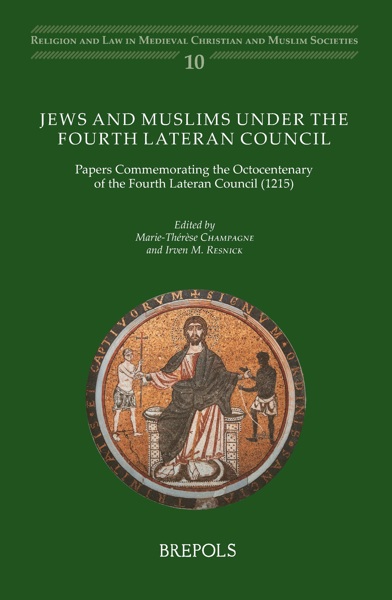
Jews and Muslims under the Fourth Lateran Council
Papers Commemorating the Octocentenary of the Fourth Lateran Council (1215)
Marie-Thérèse Champagne, Irven M. Resnick (eds)
- Pages: 280 p.
- Size:156 x 234 mm
- Illustrations:2 b/w
- Language(s):English
- Publication Year:2019
- € 85,00 EXCL. VAT RETAIL PRICE
- ISBN: 978-2-503-58151-4
- Hardback
- Available
- € 85,00 EXCL. VAT RETAIL PRICE
- ISBN: 978-2-503-58152-1
- E-book
- Available
"Der hier rezensierte Band ist (...) zur eingehenden Lektüre sehr zu empfehlen." (Ursula Ragacs, in Sehepunkte, 10/2020)
“(…) the volume does make a coherent argument: that Lateran IV did not represent a new direction in papal policies toward Jews and Muslims, but nonetheless played a key role in asserting the Church's place at the top of a hierarchy of Christian society, with religious minorities clearly identified and their freedoms constrained.” (Sarah Davis-Secord, in The Medieval Review, 21.09.28)
Co-editor Marie-Thérèse Champagne is an associate professor in the department of history at the University of West Florida; Irven M. Resnick is professor and Chair of Excellence in Judaic Studies in the department of philosophy and religion at the University of Tennessee at Chattanooga.
The Fourth Lateran Council (1215) was groundbreaking for having introduced to medieval Europe a series of canons that sought to regulate encounters between Christians and Jews and Muslims. Its canon 68 demanded that Jews and Muslims wear distinguishing dress, in order to prevent Christians from entering into illicit sexual relations with them, restricted the movement of Jews in public spaces during Holy Week, and exhorted secular authorities to punish Jews who in any way “insult” or blaspheme against Christ himself. Other canons sought to exercise greater control over moneylending, to provide relief to Christian borrowers, to extract tithes from Jews who held Christian properties as pledges, and prohibited Jews from exercising power as public officials over Christians. The canons condemned converts who preserved elements from their former religion, promoted a fifth Crusade to the East, exempted Crusaders from taxes and from interest payments to Jewish moneylenders, restricted trade with Muslims or Saracens, and condemned Christians who provided arms or assistance to Saracens. The Council’s canons affected the missionary efforts of the late medieval Church and its attempts to convert Jewish and Muslim minorities, and established essential guidance on minority relations not to be surpassed until Vatican II in the 1960s.
John Tolan, Introduction
Part I—Jews under the Fourth Lateran Council
Valerie Ramseyer, Wellesley College, Rethinking Boundaries between Christian, Jewish, and Muslim Communities in Pre-Lateran IV, Southern Italy
Alex Novikoff, Kenyon College, Performance and the Audio-Visual Jew in the Age of Pope Innocent III
Irven Resnick, University of Tennessee-Chattanooga, The Jews’ Badge
Anna Sapir Abulafia, Lady Margaret Hall, Oxford University, The Fourth Lateran Council through the Lens of Jewish Service
Rebecca Rist, University of Reading, From a Jewish Text: Anti-Jewish Papal Policy of the Lateran IV Decrees
Part II—Muslims under the Fourth Lateran Council
Ryan Szpiech, University of Michigan, Saracens and Church Councils, from Nablus (1120) to Vienne (1313-1314)
Giulio Cipollone, Pontificia Università Gregoriana, Christian and Muslim Captives Taken in Crusades and Jihād: Not a Single Word Spoken at the Fourth Lateran Council
Yvonne Friedman, Bar-Ilan University, The Crusade/Peacemaking Dichotomy: A Nuanced Approach
Clara Almagro Vidal, Universidade de Évora/CIDEHUS, Military Orders, Muslims, and the Fourth Lateran Council in Castile
Ana Echevarria, Universidad Nacional de Educación a Distancia, The Marks of the Other: The Impact of Lateran IV in the Regulations Governing Muslims in the Iberian Peninsula
Josep Hernando Delgado, Universitat de Barcelona, From Islam to Christianity: Preaching, Conversion, and the Religious Practices of Muslim Slaves from the Fourth Lateran Council through the Fifteenth Century
Appendix
Bibliography
Index




